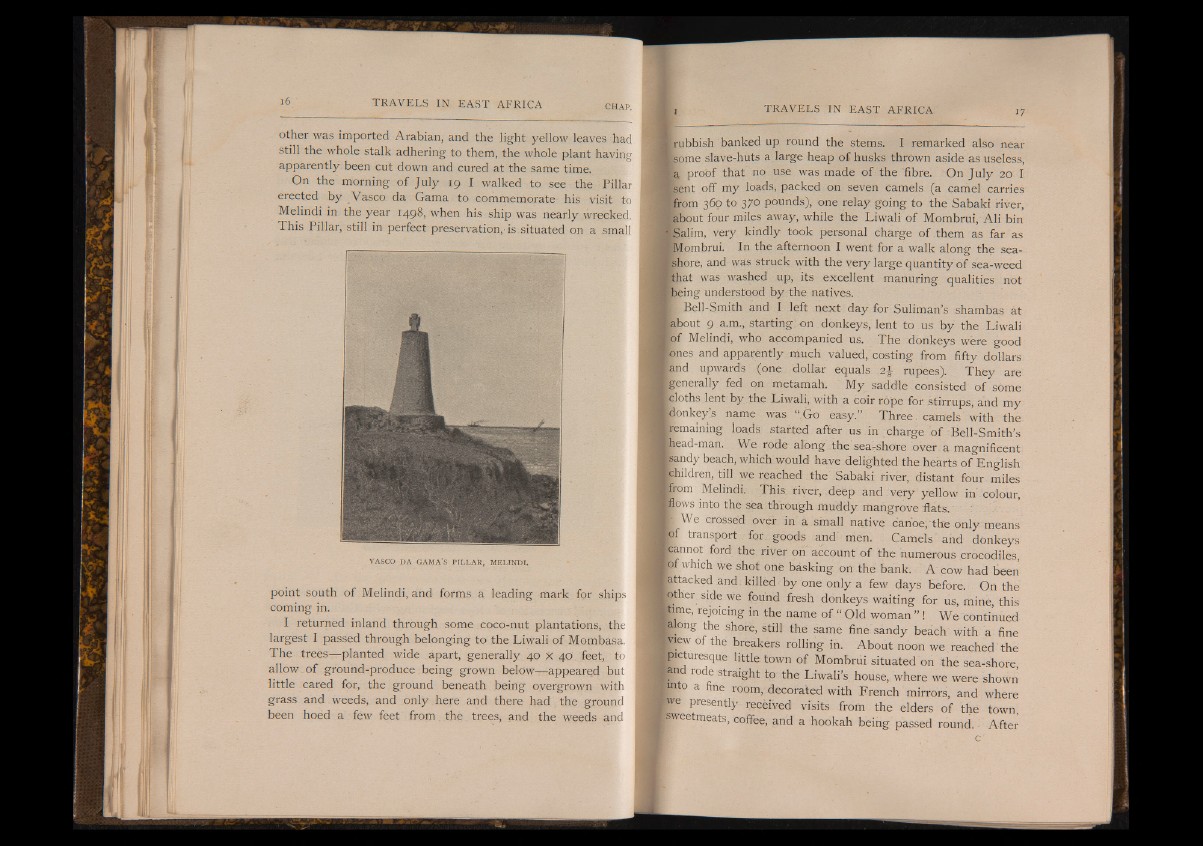
other was imported Arabian, and the light yellow leaves had
still the whole stalk adhering to them, the whole plant having
apparently been cut down and cured at the same time.
On the morning of July 19 I walked to see the Pillar
erected by Vasco da Gama to commemorate his visit to
Melindi in the year 1498, when his ship was nearly wrecked.
This Pillar, still in perfect preservation,' is situated on a small
VASCO DA GAMA’ S PILLAR, MELINDI.
point south of Melindi, and forms a leading mark for ships
coming in.
I returned inland through some coco-nut plantations, the
largest I passed through belonging to the Liwali of Mombasa.
The trees— planted wide apart, generally 40 x 40 feet, to
allow of ground-produce being grown below— appeared but
little cared for, the ground beneath being overgrown with
grass and weeds, and only here and there had the ground
been hoed a few feet from the. trees, and the weeds and
I rubbish banked up round the stems. I remarked also near
■some slave-huts a large heap of husks thrown aside as useless,
l a proof that no use was made of the fibre. On July 20 I
I sent off my loads, packed on seven camels (a camel carries
from 360 to 3/0 pounds), one relay going to the Sabaki river,
about four miles away, while the Liwali of Mombrui, Ali bin
I Salim, very kindly took personal charge of them as far as
fMombrui. In the afternoon I went for a walk along the sea-
I shore, and was struck with the very large quantity of sea-weed
1 that was washed up, its excellent manuring qualities not
I being understood by the natives.
I Bell-Smith and I left next day for Suliman’s shambas at
I about 9 a.m., starting on donkeys, lent to us by the Liwali
lo f Melindi, who accompanied us. The donkeys were good
lones and apparently much valued, costing from fifty dollars
|and upwards (one dollar equals f c 1 rupees). They are
(generally fed on metamah. My saddle consisted of some
I cloths lent by the Liwali, with a coir rope for stirrups, and my
donkey’s name was “ Go easy.” Three, camels with the
(remaining loads started after us in charge of Bell-Smith’s
head-man. We rode along the seashore over a magnificent
Isandy beach, which would have delighted the hearts of English
(children, till we reached the Sabaki river, distant four miles
pom Melindi. This river, deep and very yellow in colour,
flows into the sea through muddy mangrove flats.
»W e crossed over in a small native canoe, the only means
(of transport for goods and men. Camels and donkeys
fcannot ford the river on account of the numerous crocodiles,
|oif which we shot one basking on the bank. A cow had been
¿attacked and. killed by one only a few days before. On the
■pher. side we found fresh donkeys waiting for us, mine, this
feme, rejoicing in the name of “ Old woman ” ! We continued
Bong the shore, still the same fine sandy beach with a fine
B f w -1 breakers rolling in. About noon we reached the
picturesque little town of Mombrui. situated on the sea-shore,
B rode straight to the Liwali’s house, where we were shown
Pi o a fine room, decorated with French mirrors, and where
■e presently received visits from the elders of the town,
■jpetrqeats, coffee, and a hookah being passed round. After